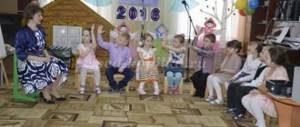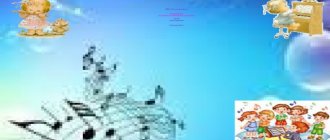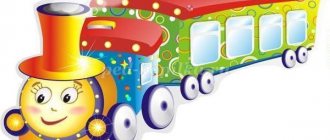The role of the music director during the period of adaptation of the child to preschool education,
Author: Stepanova Larisa Viktorovna
The role of the music director during the period of adaptation of the child to preschool.
Music is not only an ennobling and educational factor. Music is a healer of health. (V.M. Bekhterev)
A child in kindergarten is the most vulnerable link in the pedagogical process. As soon as he arrives at kindergarten, he experiences severe stress, which sometimes drags on for several months, turning into a severe form of adaptation. Over the next 4-5 years of stay in a preschool educational institution, any child may experience situations that cause strong emotional stress more than once.
The goal of the preschool educational institution is to adapt the child’s personality to society. The best approach to adaptation is a creative approach.
The work of a music director in a preschool educational institution at the present stage is filled with new content. His task is to raise a person capable of independent creative work, an active, searching person. This task can be effectively accomplished through the integration of the activities of all participants in the educational process: educators, psychologists, and additional education teachers. Taking into account the characteristics of children, they should look for the most rational and effective ways to stimulate their harmonious development.
The musical director has a special role in this matter, since musical activity is not only creative in nature, but has an impact on the development of all aspects of the personality and the sphere of cognitive development.
Therefore, the goal of the work of a teacher-musician is to preserve the child’s mental health by creating comfortable conditions for creative self-expression and personality development. In the practice of conducting music classes, music therapy methods and technologies are still used extremely rarely. At the same time, music therapy methods have been widely adapted in certain pedagogical studies in recent years to work with ordinary children in order to prevent and correct their negative emotional states, normalize the emotional and volitional sphere of the individual, promoting both spiritual, moral and physical recovery.
Of course, in music classes only scientifically based and experimentally tested elements of music therapy can be used in the form of various exercises, purposefully selected musical material for listening and performance, as well as musical and creative tasks that promote self-knowledge, self-esteem, creative self-expression, self-development and self-correction of the individual. Music helps them master the world of human feelings, emotions, and experiences. It has been established that music affects many areas of human life through three main factors: vibrational, physiological and mental. Sound vibrations are a stimulator of metabolic processes in the body at the cellular level. These vibrations can change various functions of the body (respiratory, motor, cardiovascular). Thanks to the associative connections that arise in the process of perceiving and performing music, the child’s mental state also changes.
Researchers recommend using a wide range of musical instruments and types of music that affect various body functions when working with children.
For example, to strengthen and improve the respiratory function, you can use wind instruments (clay whistles, flutes, toy pipes, harmonicas, recorders, etc.), with weak fine motor skills of the fingers - keyboard instruments (toy piano or children's synthesizer), with emotional problems, to relieve stress or, on the contrary, to activate the emotional sphere of the child’s personality - listening to music for relaxation, as well as recordings of nature noises (sounds of the sea, forest, thunderstorm, etc.)
Breathing music therapy, which includes playing wind musical instruments, breathing exercises to music and various exercises for the development of singing breathing, allows children to engage in health improvement without noticing the treatment process. Breathing music therapy is training of the respiratory function of the human body. A special place in it is given to singing. The timbre of the voice, manner of speaking, intonation, along with the meaning of the words, can tell a lot about the feelings and character of the speaker, his mood and internal state. Voice "talking musical instrument". The voice is a component of various psychophysiological processes occurring in the body. The timbre, volume and other qualities of the voice are influenced by such factors as emotional tone, muscle tone, etc. Consequently, it is possible to determine certain states of the body by the voice, and also influence these states through voice exercises.
Children especially like the sound of the metallophone. Its enchanting sounds can stop and calm a crying child, arouse interest and the desire to extract these sounds yourself. The metallophone also helps to establish children's attention; its quiet sound activates the process of listening and recognition.
Children can be offered games to distinguish the tempo and strength of sound, for example, “The children’s hands are clapping”, “The bear is walking, the fox is running, the bunny is jumping...”, etc.
To listen to music at an early age, choose small works with a bright melody, simple harmony, and simple form; medium sound strength; at a calm pace, since loud sounds excite children, and too fast a pace makes it difficult to perceive the melody, causes inadequate emotional reactions, and disordered motor activity.
It is advisable to use instrumental and vocal works by the following classical composers: P.I. Tchaikovsky, M.I. Glinka, N.A. Rimsky-Korsakov, I.S. Bakh, V.A. Mozart, L. Beethoven, F. Chopin and many others. It is classical music that contributes to the best stabilization of the psycho-emotional state of children.
Children of the third year of life can be encouraged to draw while listening to music.
The beneficial, harmonizing effect of music on children was noted during their perception of “Moonlight Sonata” by L. Beethoven, “The Swan” by Saint-Saëns, “Morning” from E. Grieg’s suite “Peer Gynt”, “Sweet Dream” by P.I. Tchaikovsky, as well as works by Mozart and Ravel.
Drawing to classical music influences children’s choice of colors - from dark tones, children gradually move to lighter, brighter tones, this allows them to relieve the internal tension of non-communicative children and concentrate and balance the state of hyperactive ones.
You can use an active version of music therapy during the lesson to stabilize the children's group. It requires the presence of simple musical instruments. Group members are encouraged to express their feelings or conduct a dialogue with any of the group members using selected musical instruments.
Choral singing can be considered as an option for active music therapy.
Vocal music is considered the highest art, because... she is natural. No matter how perfect the strings are, they cannot produce the same impression on the listener as the voice, which comes directly from the soul as the breath and is brought to the surface through the soul, mind and vocal organs of the body. When the soul wants to express itself in the voice, it first causes activity in the mind, and the mind, through thought, projects subtle vibrations onto the mental plane. They develop properly and pass in the form of breath through the region of the abdomen, lungs, mouth, throat, nasal organs, causing the air to vibrate all the time until it appears on the surface as a voice. It can be said that the voice has that magnetism that the instrument does not possess, because the voice is the ideal natural instrument on which all the instruments of the world are modeled. We need to sing more often, and then we can provide our body with an invaluable service, i.e. save him from many diseases. The healing effect of chanting: In essence, singing is chanting vowel sounds. If you sing vowels, then:
A
- saturates the body with oxygen,
E
- removes excess negative energy,
I
- actively affects the brain, eyes, nose and ears,
O
- has a healing effect on the heart and lungs,
U
- has a positive effect on the abdominal area,
E
- strengthens the cardiovascular system system,
Yu
- for diseases of the kidneys, bladder, bones,
I
- has an analgesic effect,
B
- affects the nervous system, spinal cord.
Thus, the study and use by the music director of the basics of music therapy is an important factor in the successful adaptation of the child to the conditions of stay in a preschool educational institution.
comments powered by HyperComments
Report by the music director on the joint work of the music director and teacher
Publications on the topic:
“Cooperation between a teacher and a music director in the development of children’s musicality” Among the many recent problems related to preschool education, the problem of interaction between educators and specialists stands out.
The use of information and communication technologies in the work of the music director of a preschool educational institution. The use of information and communication technologies in the work of the music director of a preschool educational institution. Kovalenok V.V., music director.
Summary of the integrated lesson of the visual arts educator and music director “White Lesson” “White Lesson” (integration of educational areas “Artistic and Aesthetic Development” direction – visual activities, etc.
Summary of the integrated joint activity of a teacher-defectologist and a music director in the middle group topic: “Adventures in the land of music (based on the “Children's Album” by P. I. Tchaikovsky)” Author: Olga Viktorovna Sazhina, teacher-defectologist.
Master class “Interaction between a music director and a teacher in the development of musical and creative abilities” Master class scenario “Interaction between a music director and a teacher in the development of children’s musical and creative abilities through.
Methodological recommendations from the music director of a preschool educational institution when working with children with visual impairments. TOPIC AND NUMBER OF HOURS 1. Day of Knowledge 4 2. Autumn 6 3. My city, my country 4 4. National Unity Day 8 5. New Year 12 6. Winter 8 7. Defender's Day.
Report on modern technologies in the work of the music director of a preschool institution Music is a source of special children's joy, and the use of various pedagogical methods in music classes solves the most important problem.
Implementation of the basic requirements of the Federal State Educational Standard in the correctional work of the music director and speech therapist of a preschool educational institution. One of the modern and priority tasks of preschool education is the protection and strengthening of the physical and mental health of children.
The use of electronic educational resources in the work of a music director of a preschool educational institution. THE USE OF ELECTRONIC EDUCATIONAL RESOURCES BY MUSIC DIRECTORS OF PRESCHOOL EDUCATION INSTITUTIONS Federal State.
Interaction between the teacher and the music director. The form of organization of music education in preschool educational institutions is determined by the interaction between the music director and the teacher. Musical director.
Music director of the 21st century
Who is he, the music director of the 21st century?! What personal qualities and professional competencies should he have, what knowledge should he have and in what ways should he convey it to the child, what veil of secrets in music and art should he lift?
The goal of the work of the music director of a preschool educational institution is to educate a spiritually enriched, harmoniously developed personality. Designing the future, laying the foundation for the future is the pedagogical mission, purpose, and, if you want, even the meaning of existence of a teacher as such.
In recent years, the issue of patriotic education of the younger generation and the restoration of lost spiritual and moral values have been discussed with passion in civil society and pedagogical circles.
Who or even what is raising a little person today? Where does he get his life values from?
The current century is marked as the century of information technology, computerization; the world today is experiencing the transition of an “industrial society” to an “information society.” The global space of the Internet is a tool for searching for new knowledge, but in the worst case, the search process turns into “wandering in the dark kingdom” of cliched pseudo-values. Each child is immersed in his own unique living environment: his family, home, friends, which influence the formation of his personality.
Little Mozart lived in an atmosphere of music and began to play music himself very early. The environment is a powerful factor in the development and education of a growing person. Thus, an important point is to create a unique educational environment and conditions, methods and approaches for the child. The educational environment today is one of the key factors in the development and education of a child, and it is important how it will be organized and equipped.
How can a teacher build this bridge between eras? Between examples of classical art of past centuries and today, with new, sometimes even at first glance incomprehensible forms and types of modern art? How to interest a child, motivate, captivate, pay attention to those things that are not around him in everyday life? The answer is obvious - we need new forms in pedagogy that correspond to the time and are dictated by the time itself. What forms and methods should a teacher choose? Today there is a search for effective modern technologies, psychological and pedagogical approaches in education.
Teachers, as well as parents, have a mission: to give the child a wonderful world - nature, things, people, to introduce him to cultural and moral values. The music director in a preschool educational institution is faced with the task of opening the world of beauty to a child, this fragile creature who is taking his first steps in this world.
A special place in the work system of a music director is occupied by TRIZ technologies in teaching preschoolers: games, activities and tasks that can increase the effectiveness of the educational program, diversify the types of children's activities, and develop creative thinking in children. TRIZ technologies make it possible to carry out a person-oriented approach in a natural way, which is relevant in the context of the Federal State Educational Standard for Education.
Computer technologies have unusually expanded the capabilities of a music director in presenting musical and didactic material provided for in the educational program of a preschool institution. The music director uses information and communication technologies and has the additional ability to transmit audiovisual information to children. Musical classes using computer technology enhance preschoolers’ cognitive interest in music and activate children’s attention, as new motives for learning the material emerge. In such classes, children are more active, the musical lesson becomes more meaningful, vibrant, harmonious and effective. An important aspect in the work of a music director is the knowledge of computer programs for working with audio and video editors for creating presentations and films.
Preschoolers receive unforgettable vivid emotions and impressions by meeting interesting people. The child will remember such meetings for many years. “Lessons in courage” from WWII veterans, master classes on unconventional drawing by professional artists, performances by classical musicians, ballet dancers, opera singers, staging plays, costume performances by theater workers.
A modern kindergarten cannot develop successfully without cooperation with society at the level of social partnership. Interaction of a preschool educational organization with government agencies, guardianship and trusteeship authorities, Veterans' Councils, public organizations, charitable foundations, interaction with educational , scientific and cultural institutions, general education and music schools, kindergartens, theaters, libraries, city parks, exhibition centers, physical education -health-improving complexes provide an additional impetus for the spiritual development and enrichment of the child’s personality from the first years of life. The development of social connections in a preschool educational institution helps improve the quality of education in general, forms a stable system of values for the child, and contributes to the successful socialization of the preschooler’s personality.
An equally important aspect of the music director’s activity is interaction with the families of students. Considering the fact that the music director does not directly interact with parents (legal representatives) as part of the educational process, it is necessary to organize joint leisure time, visit museums, exhibitions, concerts, performances, organize themed evenings in kindergarten, tea parties, competitions, master classes where informal communication, joint cooperation, exchange of experiences and interesting ideas take place. Today, parents are not “outside observers”, but “active participants” in the educational process.
Thanks to such cooperation and co-creation, parents begin to understand differently the meaning of joint work between family and kindergarten. Some parents, like their children, have become more emotional, liberated, and creative. Only parents who consider children the highest meaning of life can be called parents in the full sense of the word. For them, the interests of children always come first, especially when their children are at the most precious age - from birth to six years.
So how can a teacher keep up with the times? How to be a relevant, fashionable, modern, interesting, dynamically developing teacher, and therefore a teacher who is able to lead a child and become a role model?
The teacher himself must be an object of study for the child - a teacher - a performer on the violin, flute, a teacher - an actor in theatrical pantomime, a costume performance. The music director must learn to exist in the modern context of life, create an innovative educational space, and help support children's initiatives.
I consider it necessary and important to visit concerts, theaters, museums, and exhibitions, where a child will come into contact with “living” art and be able to immerse himself in a new educational interactive environment.
Pedagogical research is the main means of working with children. A teacher should not give children ready-made tasks or reveal the truth to them, he should teach them to find it. It is necessary to give the child the opportunity to get to the essence, to the truth of the question, to find the necessary knowledge; you should not rush to answer the child’s question; it is advisable to help the child make certain discoveries on his own with leading questions. By organizing the educational process by including preschoolers in a variety of instrumental activities, it is possible to influence all areas of children’s personality, stimulating their full development, providing conditions for self-actualization of the preschooler’s personality in the educational process. And then new modern geniuses will appear - scientists, artists.
Literature:
1. Federal state educational standard for preschool education. — order of the Ministry of Education and Science of the Russian Federation (Ministry of Education and Science of Russia) dated October 17, 2013 N 1155 Moscow “On approval of the federal state educational standard for preschool education
- Antipina G. A. New forms of working with parents in a modern preschool educational institution // Preschool teacher. - 2011. - No. 12.
3. Strauning A. M. TRIZ-RTV program for preschool children “Rostok”, volume 1: Educational manual - Obninsk: Publishing house. “Printer”, 2000. -204 p.
4. Rybak E. V. Reality and prospects for the development of social partnership in modern kindergarten / Kindergarten: theory and practice. 2013, no. 10.




